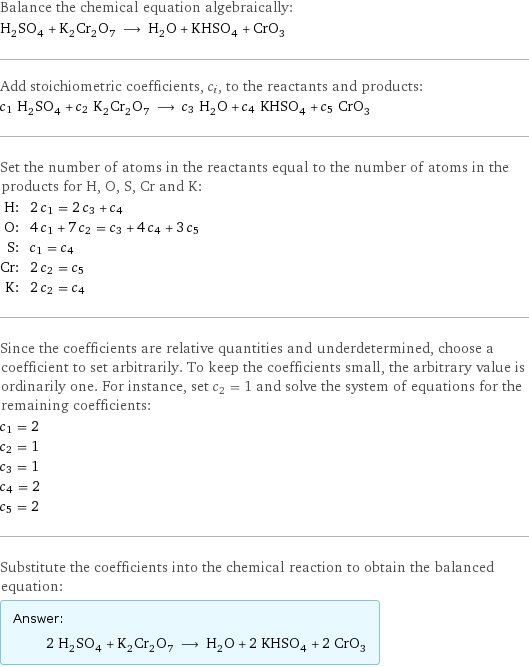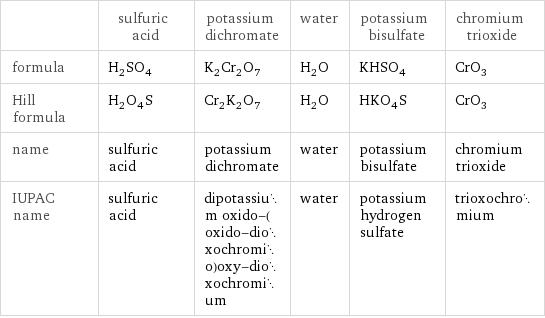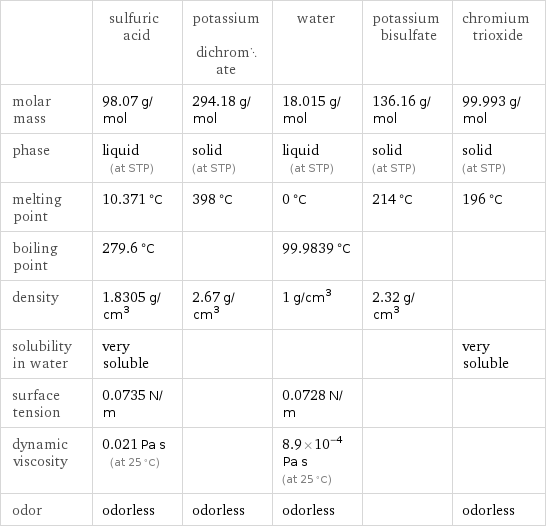Input interpretation

H_2SO_4 (sulfuric acid) + K_2Cr_2O_7 (potassium dichromate) ⟶ H_2O (water) + KHSO_4 (potassium bisulfate) + CrO_3 (chromium trioxide)
Balanced equation

Balance the chemical equation algebraically: H_2SO_4 + K_2Cr_2O_7 ⟶ H_2O + KHSO_4 + CrO_3 Add stoichiometric coefficients, c_i, to the reactants and products: c_1 H_2SO_4 + c_2 K_2Cr_2O_7 ⟶ c_3 H_2O + c_4 KHSO_4 + c_5 CrO_3 Set the number of atoms in the reactants equal to the number of atoms in the products for H, O, S, Cr and K: H: | 2 c_1 = 2 c_3 + c_4 O: | 4 c_1 + 7 c_2 = c_3 + 4 c_4 + 3 c_5 S: | c_1 = c_4 Cr: | 2 c_2 = c_5 K: | 2 c_2 = c_4 Since the coefficients are relative quantities and underdetermined, choose a coefficient to set arbitrarily. To keep the coefficients small, the arbitrary value is ordinarily one. For instance, set c_2 = 1 and solve the system of equations for the remaining coefficients: c_1 = 2 c_2 = 1 c_3 = 1 c_4 = 2 c_5 = 2 Substitute the coefficients into the chemical reaction to obtain the balanced equation: Answer: | | 2 H_2SO_4 + K_2Cr_2O_7 ⟶ H_2O + 2 KHSO_4 + 2 CrO_3
Structures

+ ⟶ + +
Names

sulfuric acid + potassium dichromate ⟶ water + potassium bisulfate + chromium trioxide
Equilibrium constant
![K_c = ([H2O] [KHSO4]^2 [CrO3]^2)/([H2SO4]^2 [K2Cr2O7])](../image_source/6cb6c1873b9303fd1ed468a7c284461a.png)
K_c = ([H2O] [KHSO4]^2 [CrO3]^2)/([H2SO4]^2 [K2Cr2O7])
Rate of reaction
![rate = -1/2 (Δ[H2SO4])/(Δt) = -(Δ[K2Cr2O7])/(Δt) = (Δ[H2O])/(Δt) = 1/2 (Δ[KHSO4])/(Δt) = 1/2 (Δ[CrO3])/(Δt) (assuming constant volume and no accumulation of intermediates or side products)](../image_source/ed22ca7560faadd7ae5b3cba536633be.png)
rate = -1/2 (Δ[H2SO4])/(Δt) = -(Δ[K2Cr2O7])/(Δt) = (Δ[H2O])/(Δt) = 1/2 (Δ[KHSO4])/(Δt) = 1/2 (Δ[CrO3])/(Δt) (assuming constant volume and no accumulation of intermediates or side products)
Chemical names and formulas

| sulfuric acid | potassium dichromate | water | potassium bisulfate | chromium trioxide formula | H_2SO_4 | K_2Cr_2O_7 | H_2O | KHSO_4 | CrO_3 Hill formula | H_2O_4S | Cr_2K_2O_7 | H_2O | HKO_4S | CrO_3 name | sulfuric acid | potassium dichromate | water | potassium bisulfate | chromium trioxide IUPAC name | sulfuric acid | dipotassium oxido-(oxido-dioxochromio)oxy-dioxochromium | water | potassium hydrogen sulfate | trioxochromium
Substance properties

| sulfuric acid | potassium dichromate | water | potassium bisulfate | chromium trioxide molar mass | 98.07 g/mol | 294.18 g/mol | 18.015 g/mol | 136.16 g/mol | 99.993 g/mol phase | liquid (at STP) | solid (at STP) | liquid (at STP) | solid (at STP) | solid (at STP) melting point | 10.371 °C | 398 °C | 0 °C | 214 °C | 196 °C boiling point | 279.6 °C | | 99.9839 °C | | density | 1.8305 g/cm^3 | 2.67 g/cm^3 | 1 g/cm^3 | 2.32 g/cm^3 | solubility in water | very soluble | | | | very soluble surface tension | 0.0735 N/m | | 0.0728 N/m | | dynamic viscosity | 0.021 Pa s (at 25 °C) | | 8.9×10^-4 Pa s (at 25 °C) | | odor | odorless | odorless | odorless | | odorless
Units
